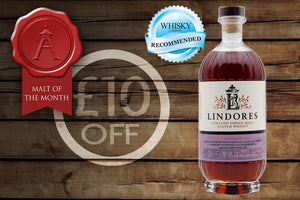
Cardhu
Cardhu distillery represents one of Diageo’s key single malts, it’s not only a vital component of the Johnnie Walker blends but is one of their most popular brands on an...
Cardhu
Cardhu distillery represents one of Diageo’s key single malts, it’s not only a vital component of the Johnnie Walker blends but is one of their most popular brands on an international scale. Set in the heart of Speyside, the distillery offers a variety of tours to visitors and from 2016 an exclusive bottling in the form of a Special Cask Reserve matured partially in ex-bourbon casks.
The distillery can trace its roots back to the formation of the Scottish whisky industry that we know today, with the vital piece of legislation in 1823 known as the Excise Act. Subject to payment of a small fee and tax on every gallon of alcohol produced, a license for distilling was granted by the government. This brought businessmen into the industry, many of whom who already had links with distilling such as blending or as grain merchants. It also granted the opportunity for those who had dabbled in illegal distilling to finally become legal, albeit at a cost. Local farmer John Cumming was one such individual to seize the opportunity and there’s solid proof that prior to 1823 he was involved illegally in distilling whisky. In fact, he used the site of the distillery as early as 1811 to produce his own whisky with the assistance of his wife to warn him when an Excise man was nearby. This should not be a surprise as the region was rife with illegal stills, hidden in Glens far away from the prying eyes of the law.
Fledgling distilleries moved from out hidden locations and down onto farms or purpose built sites for their new existence. History shows us that the illegal distillers knew exactly where the best water sources and locations were to produce whisky and many distilleries still have their roots today within these environments. John Cumming established Cardow as it was called then in 1824, before passing away in 1839 and handing ownership over to his son Lewis. He struggled to keep the distillery afloat and develop its style due to its small size, which was little bigger than a smugglers bothy. It remained within the family as in 1884, Elizabeth the daughter-in-law rebuilds the distillery on a new site having purchased land for the sum of £120. The old distilling equipment is sold in 1886 to a local man called William Grant, who is building a distillery in Dufftown that will become Glenfiddich. Under Elizabeth’s guidance the new distillery is very successful, before selling up in 1893 to a blending firm from Kilmarnock called John Walker & Son Limited. The fee was on paper a modest £20,500 but roughly in today’s money taking into account historic inflation, it would be around £1.8 million.
The new owners waste no time in extending the distillery in 1897 to increase output, by doubling the number of stills to 4, as whisky demand grows prior to the Pattison Crash in December 1898. Cardow and its owners survive the fallout and the distillery is renamed Cardhu in 1908 although many still referred to it by its original name for decades to come prompting some confusion. Then it begins the journey of acquisition towards corporate ownership, as companies become larger through combining distilleries. First with DCL in 1925, before moving onto Scottish Malt Distilleries in 1930 where it remains for several decades.
In 1960 further extension work increases the number of stills on site to 6, which is today’s current number producing annually 3.4 million litres. The expansion works do result in the destruction of a sizeable part of the original buildings also attempts have been made to retain some character. The distillery ends up as a forerunner to the Diageo we know today and opens a visitor centre in 1988 to accommodate the growing interest around whisky generally.
In 2003 the distillery is the centre of controversy with the release of the Cardhu Pure Malt. Whilst the name suggests a single malt from one distillery it is in essence a vatted malt featuring whiskies from several Diageo distilleries. Mainly intended for export, complaints were received from consumers and rival whisky producers regarding the labelling which was very similar to the existing Cardhu single malt. The whisky was withdrawn and replaced by a relaunched 12-year-old Cardhu single malt in 2005.
Very little of Cardhu is bottled independently, as it is prized by Diageo for the Johnnie Walker range and its own sizeable and popular single malt presence. The staple bottling is the 12-year old supplemented by further age statements at 15 and 18. These in recent years have been joined by a series of No Age Statement bottlings with the Gold Reserve and the Amber Rock. A Cardhu whisky is classic Speyside hence its widespread popularity with floral characteristics and a malty taste with nuts, a hint of smoke and a little sweetness.


